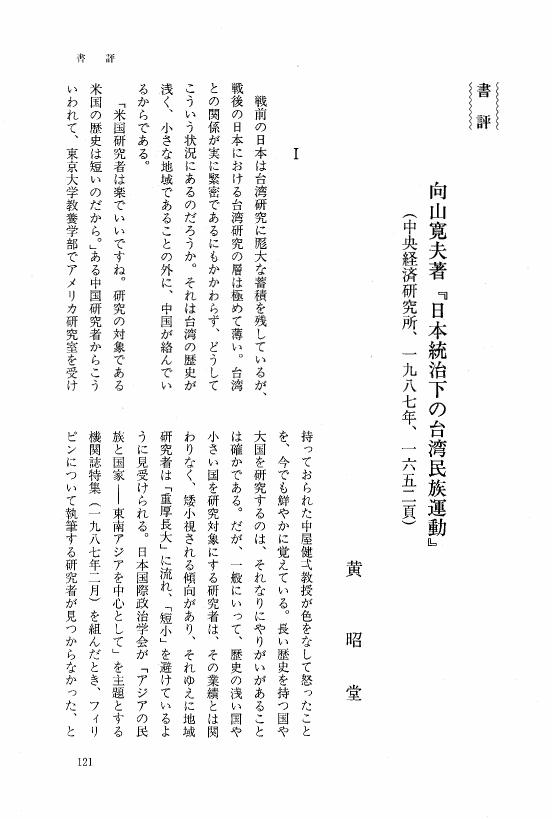2 0 0 0 「日本統治下における台湾民族運動史」向山寛夫
- 著者
- 黄 昭堂
- 出版者
- アジア政経学会
- 雑誌
- アジア研究 (ISSN:00449237)
- 巻号頁・発行日
- vol.35, no.1, pp.p121-129, 1988-10
1 0 0 0 OA 台湾の民族と国家-その歴史的考察-
- 著者
- 黄 昭堂
- 出版者
- JAPAN ASSOCIATION OF INTERNATIONAL RELATIONS
- 雑誌
- 国際政治 (ISSN:04542215)
- 巻号頁・発行日
- vol.1987, no.84, pp.62-79,L9, 1987-02-20 (Released:2010-09-01)
- 参考文献数
- 48
Taiwan has a population of 19 million, ranking in the top one-third among the 168 countries of the world. Taiwan enjoys economic prosperity symbolized by outstanding world trade which was 17th among the nations of the world in 1985. In reality, the name of the nation which exists on Taiwan is the “Republic of China”; however, this government refuses to consider the island of Taiwan as its only territory and has been struggling with the Peoples' Republic of China, both claiming the opposite side's territory as its own. The war in search of legitimacy still seems to be underway; but the will of the Taiwanese, who comprise 85% of the population of Taiwan, has been ignored for a long time. This article, which is a prelude to a forthcoming article, “The People and the Nation of Taiwan-Trends After the Second World War, ” gives the historical background of Taiwan; furthermore, it describes what the Taiwanese think about the people and the nation to which they belong.Taiwan was ruled by the Dutch, the Spanish, the Koxinga Dynasty and the Manchurian Ching Dynasty of the seventeenth century. The latest governing power lasted until 1895, when Taiwan was ceded to Japan. The native inhabitants of Taiwan were Malayo-Polynesians; they were joined by the Han immigrants from the Chinese mainland. At the end of the Dutch era, these two populations were balanced at about 40, 000 each. However, at the end of the Ching era, because the Hans continued to immigrate to Taiwan, the natives were out-numbered. Relations between the two groups were very poor, and even the Hans themselves failed to establish an identity as “Taiwanese” until the Japanese occupation in 1895.A Taiwanese consciousness was established among the Han inhabitants during the early period of Japanese occupation, perhaps because of the following: (1) resistance by force from 1895 to 1915 helped the Hans to create a “weconsciousness, ” (2) economic construction by the Japanese Taiwan Governor-General government brought communication infra-structures to the inhabitants (i. e., telephones, lengthened and widened roads and railways), (3) Japanese language instruction offered the inhabitants a mutual language; before this time, even the Hans in Taiwan were divided into two language groups.In the second decade of the 20th century, the Taiwanese political movement took over the position of resistance by force against Japanese rule. It was then that the idea of nationalism was introduced to Taiwan through the Chinese Nationalist Revolution in China in 1911. Thereafter, Han political leaders considered the Taiwanese to be a branch of the Chinese people; however, the native aborigines were still excluded. Although Han political leaders consider the Taiwanese to be a branch of the Chinese people, their idea has failed to gain support from the Taiwanese masses who consider themselves to be “Taiwanese.” The Taiwanese Communist Party established in 1928 also failed to appeal to the masses. Their slogan “Taiwanese nationalism” was not accepted. Since all of the political movements in Taiwan were oppressed by the Japanese authorities around the time of the Manchurian Incident in 1931, the Taiwanese consciousness failed to grow to form a “Taiwanese people.” The forced Japanization was accelerated until the Japanese surrender to the Allied Powers in 1945. The emergence of Taiwanese nationalism, in other words the formation of the “Taiwanese people, ” did not come about until their confrontation with the newly arrived ruler, the government of the Republic of China.
1 0 0 0 OA 向山寛夫著『日本統治下の台湾民族運動』
- 著者
- 黄 昭堂
- 出版者
- 一般財団法人 アジア政経学会
- 雑誌
- アジア研究 (ISSN:00449237)
- 巻号頁・発行日
- vol.35, no.1, pp.121-129, 1988 (Released:2014-09-15)
